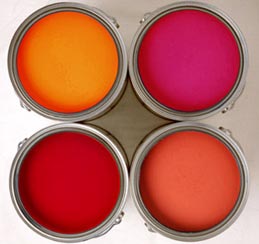Style Points: Milk Paints
This week I'm exploring paint colors for new walls. My favorite of the moment happens to be milk paint. I like the low-luster of the paint. A completely flat finish that will do well to hide wall imperfections. It is also one of those paints that won't come off easily, so it's best to do your research and a bit of experimentation.
Milk paint can be created using simple ingredients at home if you wish - this is one historical recipe:
- Powdered pigments or universal tinting colors, in the color of your choice
- Non-Fat Dry Milk
- Water
Finding the exact color you want is sometimes a trial and error process. Try creating a small batch first by using 1 cup of powdered milk with a small amount of hot water. Add the pigment or tint to create the desired color. Take careful notes about how much tint you used for the mixture. Once you have the color just right, test on a sample board and then mix up a larger batch.
Some recipes for milk paint require the addition of 1 oz. of hydrated lime for every quart of liquid. You are cautioned to use only hydrated lime and not quick lime. Hydrated lime will not react with the water.
Though I like to experiment with the colors you can obtain from the pigments. If you don't wish to experiment, milk paint comes in powder form as well. All you need to do is add water.
Milk paint can be used on walls, cabinets, furniture and craft projects. It is often layered and used with glazes. It can be used on non-porous materials, but you may need to add an extra product to make it adhere better.__________
Be Creative!
Lise










4 comments:
I am thinking about using milk paint on an old table. Should I use a primer first?
Well that kind of depends... If the table already has a finish on it, you should test the paint to see if it adheres well. You can usually test paint adhesion by sticking a piece of masking tape to the painted surface and pulling it off quickly. If any paint is removed, you should not use milk paint over the top of the original finish. If it does not come off, you should use the milk paint with a special additive to help it adhere better to the surface.
If the table has no paint or other finish, clean it well and use the milk paint for a beautiful finish.
Good luck!
Hi Lise. I noticed that BlogFlux has your site up as the most similar to mine (found here), so I thought I would come and take a look.
I like the idea of milk paint, and even though I am an artist, I have never actually heard of it! So whaddya know :D.
For one thing, it seems that milk paint is entirely environmentally friendly because of the natural ingredients. So that's a big bonus. Also, would you say that it is actually more cost effective than latex? It seems like it would be...
In any case, good post! And nice to meet you.
Michal
Hi Michal,
Nice to meet you too! I visted your blog and saw the guide to creative painting project you posted. It is awesome. I will definitely give it a try!
As for the milk paint, you're entirely correct it is environmentally friendly. Even children can use it without much fear. So it's good for classrooms and children's mural projects too.
The cost is reasonable I think, especially because you can mix up what you need to use at one time. The drawback is that the paint must be stored in the fridge, and used before the milk sours. So it's wise to mix only what you need and use it quickly.
Well worth your time to experiment with the finishes though. Let me know if you decide to try it.
Thanks for visiting - please keep in touch!
Lise
Post a Comment